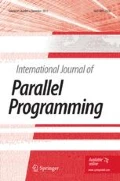Abstract
A software structure well-suited for the programming of interactive recognition and translation systems is described. This structure makes use of coroutines and backtracking in a highly coordinated and integrated fashion. A set of coroutine and backtracking primitives that supports this approach is defined. An example of the use of this approach is given.
Similar content being viewed by others
References
Bergeron, Gannon, Shector, Tompa, and van Dam, “Systems Programming Languages,”Adv. Comput. 12:175–284 (1972).
D. Berry, “Introduction to Oregano, Proceedings of a Symposium on Data Structures in Programming Languages,”SIGPLAN Not. (Feb. 1971):171–190.
D. Bobrow, “Requirements for Advanced Programming Systems for List Processing,”CACM (July 1972):618–627.
Chandy and Ramamoorthy, “Rollback and Recovery Strategies for Computer Programs,”IEEE Trans. Comput. (June 1972):546–556.
M. Conway, “Design of a Separable Transition-Diagram Compiler,”CACM (July 1963):396–408.
Feldman, Low, Swinehart, and Taylor, “Recent Developments in SAIL-An algol-Based Language for Artificial Intelligence,”Proc. FJCC (1972): 1193–1202.
R. Floyd, “Nondeterministic Algorithms,”JACM (Oct. 1967):636–644.
W. Gentleman, “A Portable Coroutine System,”Proc. IFIP (1971):419–424.
Golomb and Baument, “Backtrack Programming,”JACM (Oct. 1965):516–524.
P. Johansen, “Non-deterministic Programming,”BIT 7(4):289–304 (1967).
D. Knuth,Fundamental Algorithms, (Addison-Wesley, Reading, Mass., 1968).
Lechner and Stallings, “A Minisystem Programming Language,”Proc. ACM (1973).
Morris and Wells, “The Specification of Program Flow in Madcap 6,”Proc. ACM (1972):755–762.
A. Nevins, “A Programming Language with Automatic Goal Generation and Selection,”JACM (Apr. 1970):216–230.
C. Prenner, “The Control Structure Facilities of ECL, Proceedings of the International Symposium on Extensible Languages,”SIGPLAN Not. (Dec. 1971):104–112.
Prenner, Spitzen, and Wegbreit, “An Implementation of Backtracking for Programming Languages,”Proc. ACM (1972):763–771.
Rulifson, Waldinger, and Derksen, “A Language for Writing Problem-Solving Programs,”Proc. IFIP (1971):201–205.
Sussman and McDermott, “From Planner to Conniver-A Genetic Approach,”Proc. FJCC (1972):1171–1179.
Wulf, Russell, and Habermann, “BLISS: A Language for Systems Programming,”CACM (Dec. 1971):780–790.
Author information
Authors and Affiliations
Rights and permissions
About this article
Cite this article
Stallings, W. An application of coroutines and backtracking in interactive systems. International Journal of Computer and Information Sciences 5, 303–313 (1976). https://doi.org/10.1007/BF00998630
Received:
Revised:
Issue Date:
DOI: https://doi.org/10.1007/BF00998630




